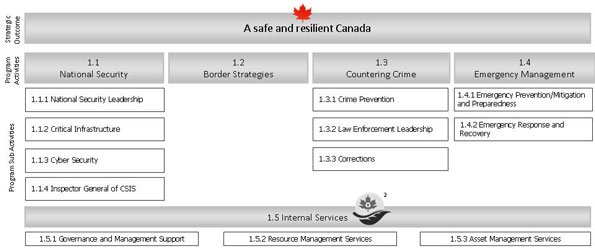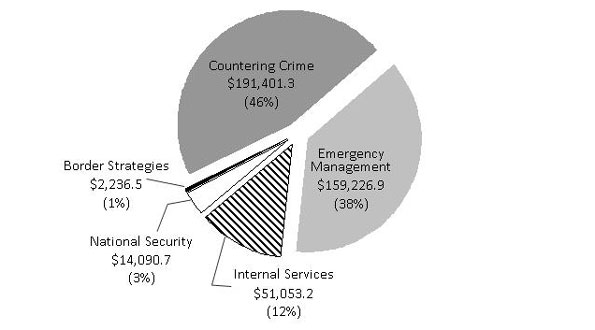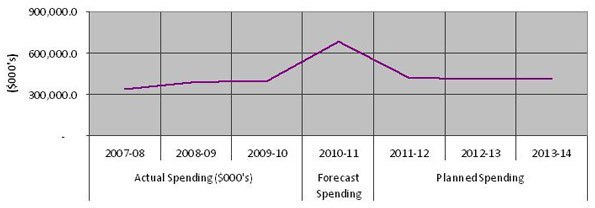Common menu bar links
Breadcrumb Trail
ARCHIVED - Public Safety Canada - Report
 This page has been archived.
This page has been archived.
Archived Content
Information identified as archived on the Web is for reference, research or recordkeeping purposes. It has not been altered or updated after the date of archiving. Web pages that are archived on the Web are not subject to the Government of Canada Web Standards. As per the Communications Policy of the Government of Canada, you can request alternate formats on the "Contact Us" page.
Minister's Message
 I am pleased to present Public Safety Canada's Report on Plans and Priorities for 2011-12. This report outlines the year's priorities and illustrates how the Department will progress over the next year to build a safe and resilient
Canada.
I am pleased to present Public Safety Canada's Report on Plans and Priorities for 2011-12. This report outlines the year's priorities and illustrates how the Department will progress over the next year to build a safe and resilient
Canada.
The Government remains committed to ensuring that Canada is protected from terrorist and other threats. Public Safety Canada plays a key role in keeping Canadian families and communities safe and secure by working to protect Canada's national security, managing our borders, reducing crime through effective law enforcement and making sure that we are prepared to deal with major incidents. The Department works closely with Public Safety portfolio partners, other government departments, provinces and territories, international allies, first responders, and the private sector to achieve results for Canadians.
Last year, Public Safety Canada had a number of accomplishments of which Canadians can be proud. The Department launched both the Cyber Security Strategy and the Critical Infrastructure Strategy; supported the G8 and G20 Summits as well as the response to the earthquake in Haiti; introduced legislation regarding migrant vessels and human smuggling; and released the Federal Emergency Response and Air India Inquiry Action Plans.
During the coming year, the Department will continue to focus in the areas of national security, emergency management response, effective law enforcement, crime prevention and border security. The Department, along with its partners, will continue to advance the Government's legislative agenda while contributing to the safety and security of this country.
Detailed information on how the Department plans on achieving these results and additional departmental commitments are provided in this report. I am confident that the values embraced at Public Safety Canada – service, unity, respect and excellence – will help guide us in our work towards a safer and more secure Canada.
The Honourable Vic Toews, P.C., Q.C., M.P.
Minister of Public Safety
Section I: Departmental Overview
Public Safety Canada's Roles and Responsibilities
Public Safety Canada plays a key role in discharging the Government's fundamental responsibility for the safety and security of its citizens. The Department of Public Safety and Emergency Preparedness Act 2005 and the Emergency Management Act 2007 set out two essential roles for the Department: (i) support the Minister's responsibility for all matters, except those assigned to another federal minister, related to public safety and emergency management, including national leadership; and (ii) coordinate the efforts of Public Safety's Portfolio agencies (outlined below), as well as provide guidance on their strategic priorities.
Mission: Building a safe and resilient Canada [1]
Vision: Through outstanding leadership, achieve a safe and secure
Canada and strong and resilient communities
The Department provides strategic policy advice and support to the Minister of Public Safety on a range of issues, including: national security; border strategies; countering crime; and emergency management. The Department also delivers a number of grant and contribution programs related to emergency management and community safety.
Public Safety Portfolio
- Public Safety Canada (PS)
- Canada Border Services Agency (CBSA)
- Canadian Security Intelligence Service (CSIS)
- Correctional Service Canada (CSC)
- Parole Board of Canada (PBC)
- Royal Canadian Mounted Police (RCMP)
- RCMP External Review Committee (ERC)
- Commission for Public Complaints Against the RCMP (CPC)
- Office of the Correctional Investigator (OCI)
Operations across Canada and Internationally
The Public Safety Portfolio encompasses nine distinct organizations which directly contribute to the safety and security of Canadians. While Portfolio agencies deliver public security operations according to their distinct mandates, Public Safety Canada, in its portfolio coordination role, brings strategic focus to the overall safety and security agenda.
Public Safety Canada is structurally organized into five branches: Emergency Management and National Security, Community Safety and Partnerships, Law Enforcement and Policing, Strategic Policy, and Corporate Management; it also has a Chief Audit Executive. The Branches are supported by the Communications Directorate and the Legal Services Unit. Also situated within Public Safety Canada is the Office of the Inspector General of CSIS, which carries out independent reviews of CSIS' compliance with the law, ministerial direction and operational policy.
The Department has regional offices in all provinces, as well as in the Northwest Territories and Yukon. These offices have a particular focus on emergency management, Aboriginal policing and crime prevention. Public Safety Canada also has staff operating in Washington, D.C. and London, England.
Strategic Outcome and Program Activity Architecture
Public Safety Canada recently revised its Program Activity Architecture (PAA) for 2011-12. The revisions do not represent a significant departure from the previous PAA, but better reflect the nature of its business and facilitate departmental reporting requirements.
The Department's streamlined PAA regroups the previous eight program activities into five:
- National Security – includes the Critical Infrastructure and Cyber Security programs, both formerly under the Emergency Management program activity;
- Border Strategies – formerly named Border Management;
- Countering Crime – incorporates the former Law Enforcement, Corrections, and Crime Prevention program activities;
- Emergency Management – includes elements of the former Interoperability program activity; and
- Internal Services.
The chart below illustrates Public Safety Canada's strategic outcome and its new Program Activity Architecture as of 2011-12. [2]

Following the development and approval of its revised PAA, the first departmental Performance Measurement Framework (PMF) was approved. The PMF outlines high-level outcomes and outputs of the Department's most prominent programs and serves as a foundational tool in creating a culture of results-based management. The outcomes presented in the PMF reflect the results that the Department's programs strive to achieve.
PAA Crosswalk
This crosswalk illustrates the redistribution of the 2010-11 forecast spending made at the program activity level between the former and new PAAs.
|
PAA Crosswalk |
New PAA |
||||||
|---|---|---|---|---|---|---|---|
|
National Security |
Border Strategies |
Countering Crime |
Emergency Management |
Internal Services |
Total
|
||
|
Former PAA |
National Security |
8,777.0 |
|
|
|
|
8,777.0 |
|
Emergency Management |
6,029.0 |
|
|
151,940.8 |
|
157,969.8 |
|
|
Law Enforcement |
|
|
374,295.7 |
|
|
374,295.7 |
|
|
Corrections |
|
|
7,955.5 |
|
|
7,955.5 |
|
|
Crime Prevention |
|
|
55,610.0 |
|
|
55,610.0 |
|
|
Border Management |
|
2,250.0 |
|
|
|
2,250.0 |
|
|
Interoperability |
|
|
|
930.5 |
|
930.5 |
|
|
Internal Services |
|
|
|
|
74,201.9 |
74,201.9 |
|
|
Total Forecast Spending |
14,806.0 |
2,250.0 |
437,861.2 |
152,871.2 |
74,201.9 |
681,990.4 |
|
Planning Summary
|
|
2011-12 |
2012-13 |
2013-14 |
|---|---|---|---|
|
Financial Resources ($000s) |
418,008.5 |
411,966.3 |
409,706.5 |
|
Human Resources |
1085 |
1095 |
1098 |
|
Alignment to Government of Canada Outcome: A safe and secure Canada [3] |
||||
|
Strategic Outcome: A Safe and Resilient Canada |
||||
|
Program Activity [4] |
Forecast Spending |
Planned Spending ($000s) |
||
|---|---|---|---|---|
|
2011-12 |
2012-13 |
2013-14 |
||
|
National Security |
14,806.0 |
14,090.7 |
13,981.8 |
14,172.0 |
|
Border Strategies |
2,250.0 |
2,236.5 |
2,246.5 |
2,230.9 |
|
Countering Crime |
437,861.2 |
191,401.3 |
190,175.8 |
190,319.2 |
|
Emergency Management |
152,871.3 |
159,226.9 |
155,173.1 |
153,804.4 |
|
Internal Services |
74,201.9 |
51,053.2 |
50,389.1 |
49,180.0 |
|
Total Planned Spending |
681,990.4 |
418,008.5 |
411,966.3 |
409,706.5 |
The figures above have been rounded to the nearest thousand dollars. Due to rounding, figures may not add to the totals shown.
Note: Planned spending reflects funds requested through the Main Estimates plus adjustments for funding approved in the Government fiscal framework. The Forecast Spending in 2010-11 represents the most up-to-date authorities.
The net decrease of $264M (or 38%) between 2010-11 forecast spending and 2011-12 planned spending is mainly due to:
- sunsetting of funding for security costs related to the 2010 G8 and G20 Leaders' Summits ($262.6M);
- sunsetting of funding provided for short-term sustainability of First Nation policing agreements and the comprehensive review of the First Nations Policing Program (FNPP) ($17.1M);
- sunsetting of funding provided for the prevention of youth gangs under the National Crime Prevention Strategy ($7.4M);
- carry-forward received in 2010-11 ($6.8M);
- reduction from 2009 Strategic Review ($6.1M) – Budget 2010;
- sunsetting of funding provided for the Critical Policing Infrastructure Program – Canada Economic Action Plan Budget 2009 ($2.8M);
- decrease to reflect funding profile provided to emergency management capacity ($2.8M);
- reimbursement of Eligible Paylist Expenditures funding included in 2010-11 forecast of spending ($2.2M); and
- other adjustments to reflect net variations ($1.6M)
(e.g. Cost Containment Measures, Collective Agreements, Employee Benefit Plans, Transfers to and from other government departments).
Offset by:
- a budget transfer to the RCMP for the FNPP made through Supplementary Estimates ($40.0M) – not yet accounted for in 2011-12;
- additional funding for implementing Canada's Cyber Security Strategy ($4.9M); and
- additional funding to support victim services and violence prevention in Aboriginal communities, as well as to increase national support for missing persons investigation ($0.5M).
Planned spending from 2011-12 to 2012-13 will decrease by $6.0M (or 1%) primarily due to:
- net decrease in funding provided to emergency management capacity ($2.8M);
- further reduction from 2009 Strategic Review ($1.5M) – Budget 2010;
- reprofiled funding to 2011-12 to conduct planned Urban Transit Exercises ($1.4M); and
- other adjustments to reflect net variations in funding for a number of initiatives ($0.3M).
Planned spending from 2012-13 to 2013-14 will decrease by $2.3M (or 0.5%) primarily due to:
- decrease to reflect funding profile provided to emergency management capacity ($1.5M);
- decrease in funding to reflect funding profile provided for implementing Canada's Cyber Security Strategy ($1.1M); and
- offset by other adjustments to reflect variations ($0.3M)
(e.g. funding for the Renewal of the Strategy for the Protection of Children from Sexual Exploitation on the Internet, funding for measures to address Contraband Tobacco).
The figure below displays the allocation of Public Safety Canada's planned spending by program activity for 2011-12.
($000s)

Estimates by Vote
- For information on organizational votes and/or statutory expenditures, please see the 2011-12 Main Estimates publication. An electronic version of the Main Estimates is available at:
http://www.tbs-sct.gc.ca/est-pre/20112012/me-bpd/info.info-eng.asp.
Contribution to the Federal Sustainable Development Strategy

Public Safety Canada is a participant in the Federal Sustainable Development Strategy (FSDS). The FSDS represents a major step forward for the Government of Canada by including environmental sustainability and strategic environmental assessment as an integral part of its decision-making processes.
The Department contributes to Theme IV of the FSDS: Shrinking the Environmental Footprint – Beginning with Government. In 2011-12, Public Safety Canada will continue to create processes, plans and tools to reduce its volume of computers and office equipment; strengthen its internal processes for reuse, disposal and/or recycling of all surplus electronic and electrical equipment; explore ways of managing and monitoring paper supply and consumption more effectively and efficiently; raise awareness of the importance of greening its operations; and include environmental considerations in purchasing decisions in conjunction with interests of price, performance and availability. Public Safety Canada will focus its attention on greenhouse gas emissions and resource consumption to help decrease the Government's overall environmental footprint. As a result, the Department will benefit from potential cost savings and contribute to reinforcing a sustainable environment.
- More information can be found in Section III – Supplementary Information: Greening Government Operations table, and the Departmental Strategic Environmental Assessment at: http://www.publicsafety.gc.ca/abt/dpr/2011-2012/sdsea-eng.aspx.
- Complete details on the Government's Federal Sustainable Development Strategy, can be found at: http://www.ec.gc.ca/dd-sd/default.asp?lang=En&n=C2844D2D-1.
Risk Analysis
By its very nature, Public Safety Canada's work involves a continuous assessment of threats in a broad operating environment, which can be transnational, national or local in scope, immediate and/or longer term. A challenge to the Department is a rapidly evolving threat environment, and as such, priorities and capacities must quickly adjust to respond to new threats. For example, the increased reliance of Canada and Canadians on cyber technologies increases the government's exposure to those who attack the digital infrastructure, or who would use that infrastructure for malicious intent. To help respond to this risk, the Department will coordinate efforts between federal departments and agencies to secure the Government's information systems from cyber threats.
Regarding national security, it will be necessary for the Department to enhance policies and other tools to address gaps in its ability to address evolving threats (e.g. violent extremism), as well as to clarify the authorities for sharing information for the purpose of national security. To help mitigate this risk, Public Safety Canada will work with other government departments and agencies to continuously enhance responses to national security threats, and aim to develop an internal mechanism to ensure accountability and compliance with the laws and policies which govern national security information sharing.
A coordinated whole-of-government approach to emergency management planning will strengthen the Government of Canada's capacity to prevent, protect against, respond to and recover from major disasters and other emergencies. To support federal institutions in emergency planning, Public Safety Canada will lead a federal initiative to develop a whole-of-government all hazards risk assessment framework to identify key safety and security risks to Canadians. Given the importance of adequate infrastructure for delivering critical programming and functions, the Department must ensure that its own emergency management infrastructure is up to date and responsive.
Public Safety Canada has a broad mandate which includes leadership at the national level for matters pertaining to public safety and emergency preparedness. This requires collaboration with more than 30 departments and agencies, provincial and territorial governments, international partners, the private sector and first responders. The effectiveness of these relationships affects the work of the entire Department and is key not only to the successful advancement of its policy and program agenda, but also to the achievement of Public Safety Canada's strategic outcome of a safe and resilient Canada. This is demonstrated in the federal-provincial-territorial collaboration necessary for the Department to finalize and ratify the RCMP Police Service Agreements with the Provinces.
Priorities Summary
In pursuit of the strategic outcome of a safe and resilient Canada, the Department will prepare the groundwork for the Government's future policy initiatives, and in particular support the Government's legislative agenda.
| Operational Priorities | Type | Links to Strategic Outcome(s) | Description |
|---|---|---|---|
| Priority 1: Enhance Canada's approach to national security including a focus on countering violent extremism and improving information sharing | New | National Security, Countering Crime |
Contribution of Priority to Strategic Outcome: Public Safety Canada plays an essential role in ensuring a robust and relevant national security framework. It collaborates with domestic and international partners, helping to protect Canada and its allies from new, rapidly evolving threats and challenges to national security, while balancing the need for oversight, accountability and the protection of civil liberties. The Department addresses identified national security threats using a framework of laws, policies and priorities and in 2011-12, will continue to enhance this framework by identifying and addressing gaps, as well as strengthening the mechanisms that govern how national security activities are carried out. Policy options will be developed to address challenges associated with foreign nationals in Canada considered inadmissible for national security reasons, as well as to address challenges related to the potential liberalization of foreign investment in the telecommunications sector. In addition, the Department will develop policy responses to counter violent extremism and develop measures to strengthen Canada's domestic capacity to counter proliferation threats. It will also continue to benefit from the advice provided by the Cross-Cultural Roundtable on Security, a forum of Canadian citizens from diverse backgrounds, in developing its national security policies and programs. In response to the Commission of Inquiry into the Investigation of the Bombing of Air India Flight 182, the Government released the Air India Inquiry Action Plan for which the Department will advance a number of commitments to address outstanding concerns with Canada's security and intelligence regime. To measure success in achieving this priority, the Department will use the following indicator in addition to the indicators in the PMF:
To achieve this priority, the Department will support a number of initiatives including the following:
|
| Priority 2: Strengthen the emergency management function with a particular focus on modernizing the operations of the Government Operations Centre | New | Emergency Management |
Contribution of Priority to Strategic Outcome: The Department develops national policies, response systems, protocols and standards to reduce the impact of emergencies that could affect Canada's population and infrastructure. Efforts include national leadership, enhancing the Government of Canada's readiness to respond to all types of emergencies, improving information sharing and collaboration with other levels of government and the private sector, as well as enhancing interoperability with federal departments and agencies, other levels of government, and among emergency responders and practitioners. In 2011-12, the Department will continue to focus on its federal leadership role in response to the recommendations contained in the Auditor General's Fall 2009 report on emergency management to ensure a coordinated, integrated federal response to emergencies. It will work to strengthen the Government Operations Centre's ability to support senior officials and to provide strategic level coordination on behalf of the federal government in response to emerging or occurring events affecting the national interest; as well as develop an implementation plan to ensure that the Government Operations Centre is able to fulfill its mandate. To measure success in achieving this priority, the Department will use the following indicators in addition to the indicators in the PMF:
To achieve this priority, the Department will support a number of initiatives including the following:
|
| Priority 3: Provide national leadership to support policing in Canada, including finalizing and ratifying the RCMP Police Services Agreements and renewing the First Nations Policing Program Agreements | Ongoing | Countering Crime |
Contribution of Priority to Strategic Outcome: To measure success in achieving this priority, the Department will use the following indicators in addition to the indicators in the PMF:
To achieve this priority, the Department will support a number of initiatives including the following:
|
| Priority 4: Provide national leadership in implementing Canada's Cyber Security Strategy including a focus on threats to Canada's critical infrastructure | New | National Security |
Contribution of Priority to Strategic Outcome: To measure success in achieving this priority, the Department will use the following indicators in addition to the indicators in the PMF:
To achieve this priority, the Department will support a number of initiatives including the following:
|
| Priority 5: Strengthen departmental policy leadership through enhanced Portfolio engagement | New | National Security, Border Strategies, Countering Crime, Emergency Management |
Contribution of Priority to Strategic Outcome: The Department plays a key role in developing policies, delivering programs, as well as ensuring cohesion and integration on policy and program issues within the Public Safety Portfolio. In 2011-12, it will continue to consult with the Portfolio to ensure that services and programs reflect public safety priorities and objectives, as well as address the operational requirements of the Portfolio. Furthermore, Public Safety Canada will continue to lead efforts, including on behalf of Portfolio partners, to strengthen its ability to learn from and collaborate with other government departments, and leverage participation in broader initiatives, towards supporting policy and program priorities. To measure success in achieving this priority, the Department will use the following indicator:
To achieve this priority, the Department will support a number of initiatives including the following:
|

